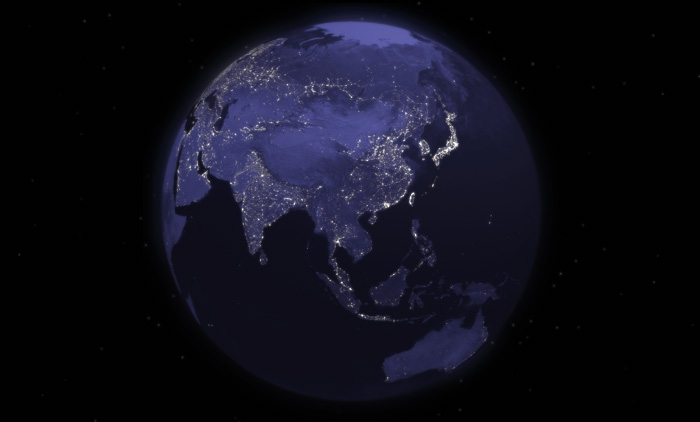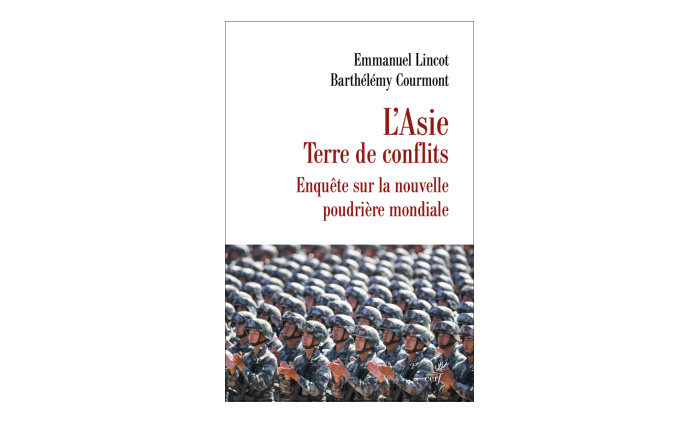Analyses / Asia-Pacific
12 February 2025
Is Asia the Next Global Powder Keg?

If the past few years have been particularly marked by the return of war and instability in the Middle East as well as on the European continent, other conflict hotspots could emerge in the coming years, particularly in Asia. Attention is primarily focused on China, whose ambitions to reclaim Taiwan, as well as its expansion in the South China Sea, raise concerns about the risk of war with the United States and its allies. India, which also harbours significant ambitions, could likewise find itself in confrontation with Beijing, particularly against the backdrop of its rivalry with Pakistan and border disputes in the Himalayas. Tensions across the continent also extend to the Korean Peninsula and Western Asia, exacerbated by religious divisions and the nuclear threat.
What are the potential conflict zones that could set Asia ablaze? How are China’s economic ambitions perceived by other countries? To what extent is religion a factor of tension? Should the nuclear threat be taken seriously?
A discussion with Barthélémy Courmont, Director of Research at IRIS in charge of the Asia-Pacific Programme, and Emmanuel Lincot, Associate Researcher at IRIS specialising in Asia, on the occasion of the release of their book L’Asie, terre de conflits, enquête sur la nouvelle poudrière mondiale ? published by Éditions du Cerf.
What are the conflict hotspots that could make Asia the future global powder keg?
No region in Asia is spared from risks of conflict, varying in intensity, although East Asia and the Taiwan issue currently attract the most attention due to the risks of large-scale confrontation. A Chinese aggression against the island would likely trigger a chain reaction from the United States and Japan. It would certainly ignite the region and far beyond, as US allies, especially NATO member countries, would find it difficult to remain passive. This would be a global conflict, regardless of each country’s involvement on the ground. This possibility presents an even greater risk than the Russia-Ukraine war, which has also played into China’s hands in Central Asia while fueling rivalries between countries in the region.
The same is true for the Sino-Indian rivalry. It could intensify further as Moscow weakens, prompting India to shift more towards the Indo-Pacific, including seeking closer ties with the United States—although this remains subject to various uncertainties. Chinese think tanks, which once treated Indian affairs with indifference, have now changed their stance. India has become a serious concern for China due to the border disputes between the two states, as well as the close ties between China and Pakistan, India’s systemic rival. Indian diplomacy carries a deep-seated negative prejudice against China, stemming from the 1962 defeat when the Indian Army was routed in Aksai Chin in the Himalayas. This defeat was experienced as a national trauma, and China continues to be viewed by Indian public opinion as a rival, if not an enemy. Furthermore, under Narendra Modi, India increasingly sees itself as a besieged nation. China’s strong economic and strategic presence in the Maldives and other regions, such as the Himalayas, Myanmar, and possibly Bangladesh after Dhaka’s regime change last summer, reinforces this fear. The two countries have converging interests, but they remain competitors, and their rivalry could push the region toward escalating tensions. Other hotspots cannot be ignored, from the Korean Peninsula to the South China Sea, where rivalries and the risk of escalation remain high due to China’s assertion of power, Russia’s desire to reposition itself in Asia, and the emergence of new actors, particularly in Southeast Asia. Western Asia is not immune either: the collapse of Bashar al-Assad’s regime in Syria marks a partial victory for Turkey and Israel in the region and weakens the Iranian regime, which has been supported by both Moscow and Beijing. China is struggling in the region, especially as the new Syrian regime is made up of Uyghur supporters. Furthermore, the region is at the heart of rivalries between two competing trade projects: China’s Belt and Road Initiative, and the IMEC (India-Middle East European Corridor), supported by India, Israel, and Western countries. In short, the crisis hotspots are numerous, and China has, so far, failed to establish itself as a peacemaker.
This rise in tensions in Asia has been extensively discussed in our book, which has been designed as a manual that can always be referred to for historical fundamentals, as well as for subjects generally underexplored or overlooked, such as the geopolitics of heritage or the memory issues dividing the countries of Asia. The entire book is complemented by exceptional maps created by the cartographer Philippe Audette.
China is developing its “Belt and Road Initiative” (BRI) across the continent and globally. What impact will this have on the security of the continent?
Launched in 2013, this project, with an initial investment of 1 trillion dollars, has since reached 9 trillion according to some experts. In comparison, the European Union has only allocated 300 billion for its Global Gateway project. The ambitions are clearly not the same. This is especially evident in Central Asia, where Chinese investments meet the very concrete needs of the countries involved in the field of infrastructure. Roads, bridges, tunnels, and railways are shaping the region and aim to open it up. However, this frantic economic development comes with a significant risk of indebtedness and a paradoxical sense of sinophobia. This is explained either by the fear of alienation among the populations or by a sense of solidarity with the Uyghur Muslims, and thus, by extension, against the Chinese. China has scaled back its investments, particularly in Africa, but it cannot completely abandon them, as the project has created a network of interdependencies initiated by China. Much more than Moscow, Beijing has been able to materialise its alternative to the West, both economically and ideologically. This interpretation also helps to understand the “Chinese Dream” (Zhongguo meng). From a soft power perspective, this project is perhaps less likely to evoke desire compared to the American Dream, which Elon Musk seems to have revived through his ambitions to conquer Mars. But regardless, the Belt and Road Initiative has reshuffled the cards and, barring political surprises, set the tone for international relations for a long time. Indeed, as has been understood, this project is not just economic. Through its diverse approaches, it generates both support and rejection, as seen in Europe, where fault lines divide the South and East of the continent from the West. It is thus both restructuring and deconstructing, and consequently carries economic and social uncertainties in the new balances taking shape, as well as possible tensions along different fronts.
While Islamic terrorism remains highly prevalent in Asia, to what extent does religion play a role in regional tensions?
Religion primarily serves as an identity cement and a political reference, through the concepts of umma (the community of believers) and the Caliphate, which for many represents an imperial response through a return to the fundamentals of Islam. This form of conservative revolution does not, however, entirely reject the idea of technological progress. The Islamic State, for example, has attracted and continues to attract highly skilled geeks for its propaganda needs. These cultural and ideological references are subject to various interpretations depending on whether one is Sunni or Shia, particularly in Pakistan, where the fate of the Hazara community, expelled over twenty years ago from Afghanistan by the Taliban into Balochistan, has been closely observed within the Shia community. In return, Iran’s support for these communities is an existential manifestation of its power against a Sunni majority, which benefits from Saudi Arabia’s largesse.
Thus, Islam, in its most radical form, is instrumentalised for political purposes—either because it aligns with the interests of powers or because it provides significant legitimacy to a clan or brotherhood whose livelihood sometimes depends on drug trafficking, which is particularly the case in the most fragile countries and regions of Central Asia: Kyrgyzstan, Balochistan, Afghanistan, Tajikistan, and Kashmir. Drug trafficking is a serious issue and is a major concern for China, which knows that the drug trade led to the collapse of its last imperial dynasty. China has therefore secured the creation of two military bases in Tajikistan, in the High Badakhshan region, enabling its army to patrol the area and eradicate militias, including Uyghur groups, whose main source of income is drug trafficking.
The religious factor also plays a crucial role in tensions in South Asia, particularly between India and Pakistan, especially since Narendra Modi’s rise to power within Indian society. In Southeast Asia, a true mosaic where major religions (Buddhism, Christianity, Islam, Hinduism) have coexisted for centuries, tensions related to religious radicalism create insecurity and interreligious conflicts, often exacerbated by ethnic factors. This is evident in the Philippines, Indonesia, and more notably in Myanmar, which has returned to civil war conditions. While regional cooperation exists, particularly to combat radical movements, security risks are numerous, and the possibility that political actors could be profoundly destabilised by internal pressures cannot be ignored.
Asia (excluding the Middle East) has five nuclear powers. To what extent should the nuclear risk be feared on the continent in the event of open conflicts?
The risk is particularly high between India and Pakistan, where the threat of using tactical nuclear strikes at Kargil in 1999 was real. It is not impossible that China could be tempted to resort to nuclear weapons either against India or Taiwan, and in this regard, Putin’s threats about the use of nuclear weapons in Ukraine have, of course, shifted the lines. China’s deterrence doctrine could be altered, and its principle of never striking first might be abandoned. As for North Korea, nuclear weapons are primarily a lifeline for the regime, even though caution is required regarding the proliferation risks that Pyongyang might initiate. Nuclear weapons always carry large-scale risks, particularly with the presence of several nuclear powers, some of which are not recognised by the Non-Proliferation Treaty, in addition to Iran, which many experts in the Western world accuse of being on the brink of conducting its first test.
However, the nuclear factor can also, when handled wisely, impose negotiation in order to avoid the strategy of chaos. This is why it is essential to observe the positions of nuclear powers, both globally and particularly in Asia, to understand the real risks.



